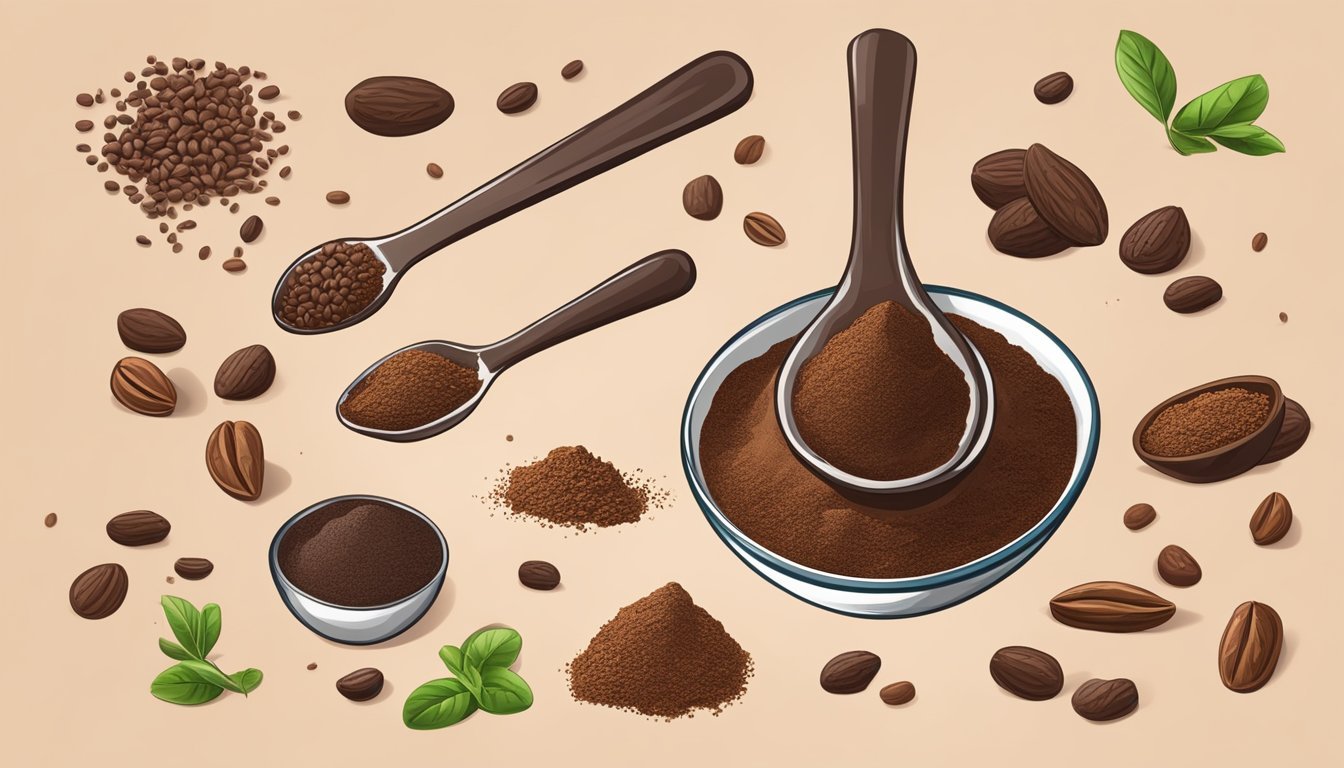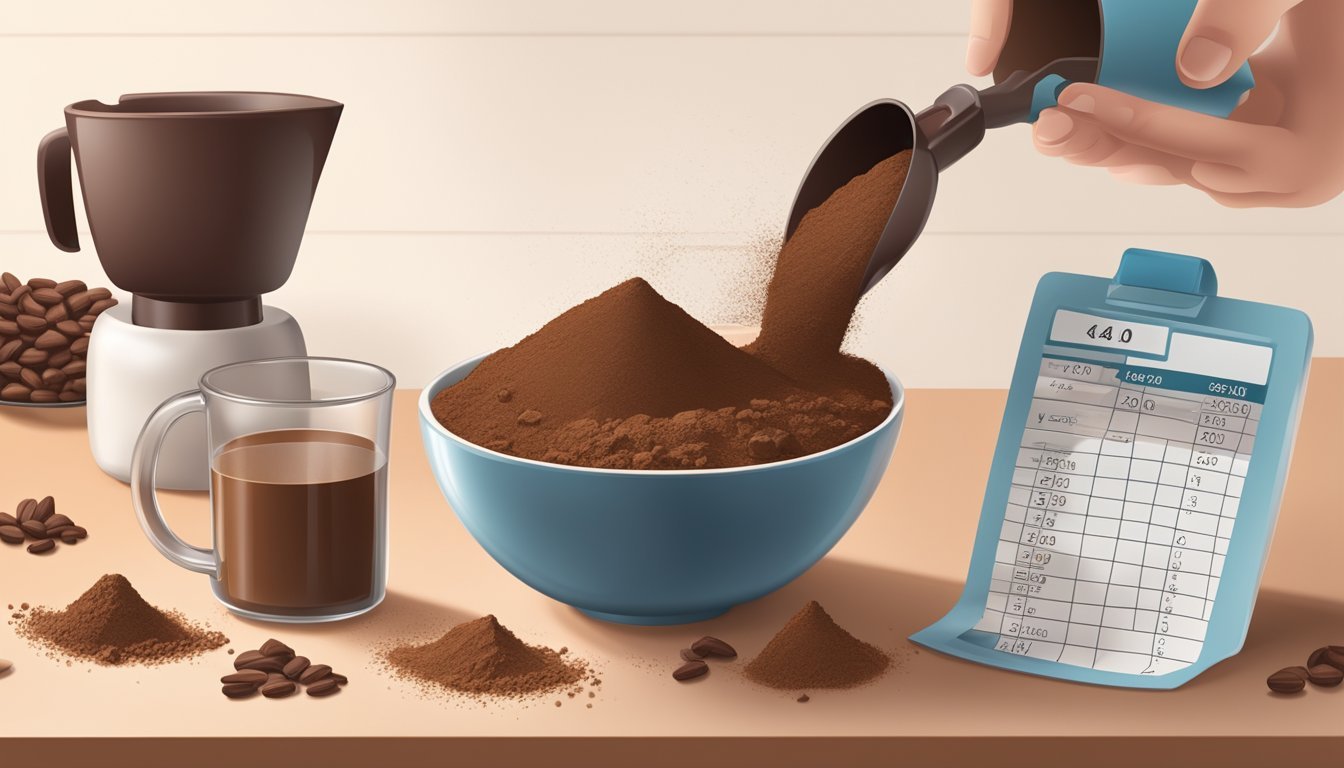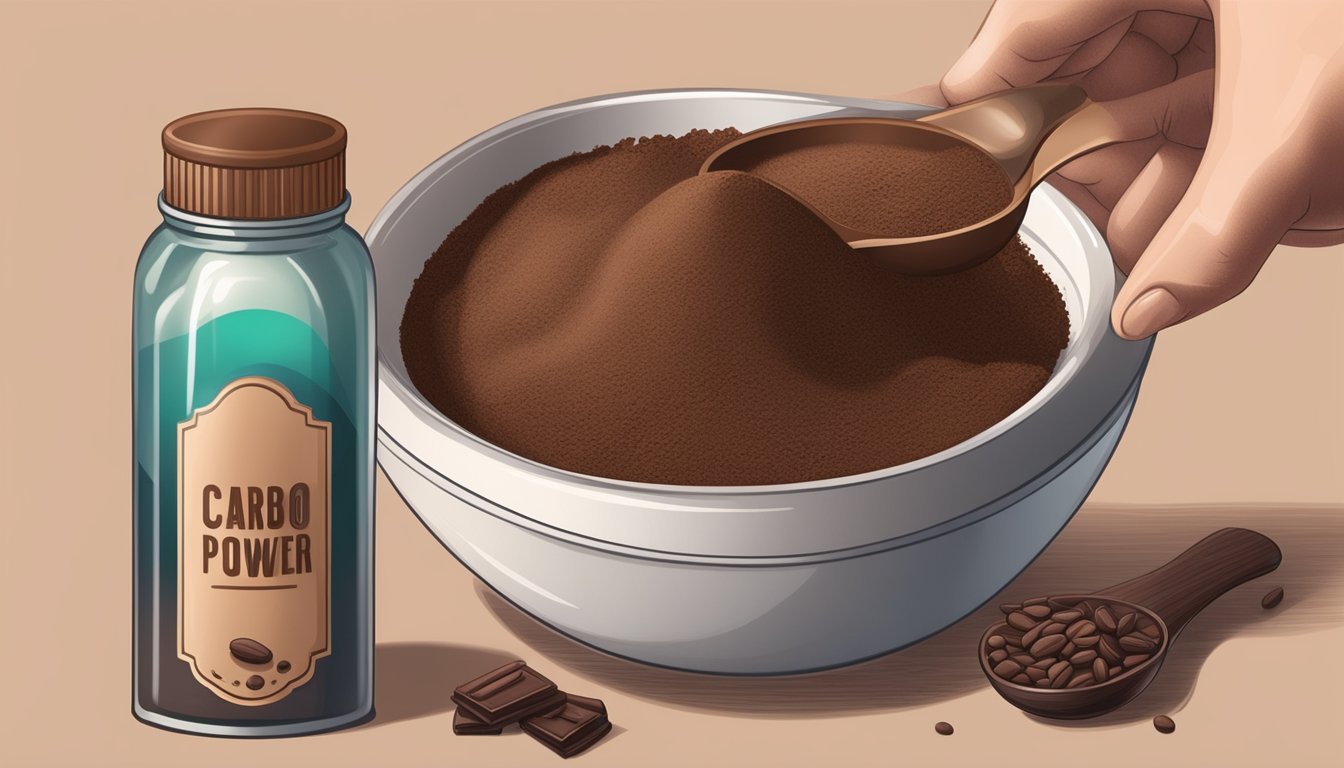How to Substitute Cocoa Powder
Simple Baking Swaps
When baking or cooking, one may find themselves lacking a key ingredient: cocoa powder. This pantry staple is essential for imparting rich chocolate (What wine goes well with chocolate?) flavor to a variety of desserts and dishes. Fortunately, there are several alternatives available that can mimic the taste and color of cocoa powder, ensuring that the absence of it doesn't halt the cooking process.
Substituting cocoa powder requires understanding its role in a recipe. Typically, cocoa powder adds depth of flavor, a distinct chocolate taste, and a dry, powdery texture. Substitutes such as melted dark chocolate, carob powder, and Dutch-processed cocoa offer varied flavor profiles and textural differences but can achieve a similar outcome when used correctly. Each substitute comes with its own set of proportions and potential adjustments to other ingredients to maintain the balance in recipes.
Understanding Cocoa Powder
Cocoa powder plays an indispensable role in countless recipes, providing a rich chocolate flavor derived from cacao beans. This section uncovers both the fundamentals of cocoa powder and the distinctions between its two most common forms.
The Basics of Cocoa Powder
Cocoa powder is made from cacao beans, the seeds of the cacao fruit. After harvesting, the beans are fermented, dried, roasted, and cracked into cocoa nibs. These nibs are then ground into a paste called chocolate liquor. The liquor is pressed to separate cocoa solids and cocoa butter (how long does butter last?). The solids are finely ground into the powder known as natural cocoa powder which is packed with flavonoids, natural compounds known for their antioxidant properties.
How is cocoa powder made:
Fermentation
Drying
Roasting
Cracking into nibs
Grinding into chocolate liquor
Pressing to separate solids and butter
Grinding solids into powder
Differences Between Natural and Dutch-Process Cocoa Powder
Natural cocoa powder is acidic and bitter, retaining most of the natural properties of the cacao bean. Dutch-process cocoa powder, on the other hand, is treated with alkalizing agents to neutralize its acidity, resulting in a milder flavor and a darker color. The Dutch-process variant dissolves more easily in liquids due to its reduced acidity.
Characteristics Comparison:
Property Natural Cocoa Powder Dutch-Process Cocoa Powder Acidity Higher acidity Neutral pH Flavor Bitter and intense Milder and smooth Solubility May not dissolve easily Dissolves easily Reaction with Baking Soda Reactive due to acidity Minimal reaction Color Lighter brown Darker brown
It's important for bakers to note that the type of cocoa powder used can affect the outcome of a recipe due to these differences in pH and flavor profile.
Cocoa Powder in Baking
In baking, cocoa powder is essential for imparting the distinct chocolate flavor and color, while also interacting with leavening agents to affect the texture and rise of the final product.
Role of Cocoa Powder in Recipes
Cocoa powder is the concentrated essence of fermented, dried, and roasted cacao beans, which is then processed to remove fat. Its use in recipes extends beyond adding a rich chocolate flavor; it also contributes to the overall structure and color of baked goods. Recipes may specifically call for either natural or Dutch-processed cocoa powder, and it's important to use the type specified for a successful outcome.
Chocolate flavor: Cocoa powder imparts a deep, rich chocolate flavor that is fundamental in chocolate baked goods.
Texture of baked goods: It helps in the absorption of liquids, thus contributing to the density and moisture of the end product.
Interplay Between Cocoa Powder and Leavening Agents
The interaction between cocoa powder and leavening agents like baking soda (sodium bicarbonate) and baking powder is a fine balance necessary for the desired rise and texture.
Leavening: Both baking powder and baking soda are leavening agents that release carbon dioxide when combined with a liquid. The resulting gas bubbles help baked goods rise.
Leavening Agent Interaction with Cocoa Powder Baking Soda (Basic) Requires an acidic counterpart to react. Baking Powder (Neutral) Contains acid and base and can work without acid.
Natural Cocoa Powder (Acidic): When combined with baking soda, a chemical reaction occurs, contributing to the leavening of the dough or batter.
Dutch-Processed Cocoa Powder (Neutral): This type of cocoa powder has been alkalized and does not react with baking soda. It is typically paired with baking powder for leavening.
Bakers must match the correct type of cocoa powder with the appropriate leavening agent to ensure the ideal rise and texture of chocolate baked goods. Using a mismatched combination can lead to flat, dense, or improper results.
Substituting Cocoa Powder
When a recipe calls for cocoa powder and it's not available, there are several reliable substitutes that can emulate its rich flavor and color. Each alternative has a specific ratio to cocoa powder and can affect the outcome of the baked goods, so it’s essential to choose wisely and adjust quantities as necessary.
Substitute Options for Cocoa Powder
Baking Chocolate: For every 3 tablespoons of cocoa powder, one can use 1 ounce of unsweetened baking chocolate by melting it and incorporating it into the recipe. Be mindful to reduce the fat content elsewhere, if possible, since baking chocolate also includes cocoa butter.
Carob Powder: Carob powder can replace cocoa powder at a 1:1 ratio and is naturally sweeter, allowing for a reduction in the sugar added to the recipe.
Chocolate Chips: Ground chocolate chips can substitute cocoa powder; 1/2 cup of ground chocolate chips can replace roughly 3 tablespoons of cocoa powder.
Dutch-processed Cocoa: Swap each tablespoon of natural cocoa powder for an equal amount of Dutch-processed cocoa and a pinch (1/8 teaspoon) of baking soda to neutralize the acidity.
Drinking Chocolate Powder: While sweeter, one can use this in a pinch, substituting 1 tablespoon of cocoa powder with 1.5 tablespoons of the sweetened mix.
Baking Chocolate as a Substitute
When using unsweetened baking chocolate to replace cocoa powder, the key is understanding the composition of the chocolate being used. Baking chocolate typically contains cocoa solids and cocoa butter, which will introduce more fat into the dish. High-quality dark chocolate or couverture, which has a higher percentage of cocoa butter, can also be used, especially for richer desserts.
Conversion Guide:
Unsweetened Baking Chocolate: 1 ounce melted for every 3 tablespoons of cocoa powder
Dark Chocolate: 4 tablespoons melted for every 3 tablespoons of cocoa powder
Couverture Chocolate: Use sparingly due to high cocoa butter content; adjust the recipe's fat and sugar accordingly.
Carob Powder and Other Alternatives
While carob powder is the less common cocoa powder substitute, it provides a unique flavor and is naturally sweet. It can be a great alternative for those looking to reduce the caffeine content in their desserts.
Other Alternatives Table:
Substitute Conversion to Replace 3 Tbsp Cocoa Powder Carob Powder 3 tablespoons Ground Chocolate Chips 1/2 cup Dutch-processed Cocoa 3 tablespoons + 1/8 tsp baking soda Drinking Chocolate Powder 1.5 tablespoons
These substitutes can be used in a variety of recipes including cookies, brownies, cakes, and muffins. It's important to adjust sweetness levels and dry to wet ingredient ratios based on the substitute used to achieve a comparable end product.
Cocoa Powder and Dietary Considerations
When substituting cocoa powder, individuals must consider dietary restrictions such as lactose intolerance, veganism, and the need to manage intake of sugar and fat.
Non-Dairy Alternatives
For those with lactose intolerance or following a vegan diet, non-dairy alternatives are essential when replacing cocoa powder in recipes.
Carob Powder: It can be used in a 1:1 ratio with cocoa powder for baking goods like cookies and cakes. For hot chocolate, blend carob powder with a non-dairy milk alternative such as almond, soy, or oat milk.
Dark Chocolate: Choose a dark chocolate with a high cocoa content and no dairy additives. It can be melted and incorporated into recipes to achieve a rich flavor similar to cocoa powder.
Alternatives for Sugar and Fat
Substitutes that adjust the sugar and fat content are important for those managing their dietary intake of these components.
Unsweetened Baking Chocolate:
Substitute: 1 ounce unsweetened baking chocolate for 3 tablespoons of cocoa powder.
Adjustments: Add sugar and fat, such as oil or non-dairy butter, to compensate for the lack of these in the unsweetened chocolate.
Dutch-processed Cocoa:
Substitute: 3 tablespoons of Dutch-processed cocoa powder plus 1/8 teaspoon of baking soda for every 3 tablespoons of natural cocoa powder.
Note: This cocoa has been alkalized to remove acidity and is often paired with baking soda to maintain leavening.
Adjusting Recipes for Substitutes
When substituting ingredients in recipes, one must consider the balance of flavor and texture that the original ingredient provides. Cocoa powder, with its unique combination of acidity, chocolate flavor, and dry texture, impacts both the taste and structure of a dish.
Balancing Acidity and Sweetness
Cocoa powder often imparts a certain level of acidity to recipes, which can be balanced by adding an acidic ingredient if a less acidic substitute is used. Options for introducing acidity include:
Lemon juice: A small amount can adjust the pH level.
Vinegar: Similarly to lemon juice, a dash can be used.
Cream of tartar: Acts as both a leavening agent and acidity balancer.
In terms of sweetness, unsweetened chocolate can serve as a substitute without altering sugar content significantly. Should a sweeter chocolate be used, such as semisweet, the amount of sugar in the recipe should be reduced accordingly to maintain the desired flavor profile.
Maintaining Moisture and Fat Content
Cocoa powder lacks the milk solids and cocoa butter found in chocolate bars, which contribute to the moisture and fat content of a dish. When using melted chocolate in place of cocoa powder, these factors need to be adjusted. One may need to decrease other sources of fat, such as:
Butter: Reduce the amount if using chocolate with a high cocoa butter content.
Oil or Shortening: These can be decreased as well when substituting with melted chocolate.
For maintaining the appropriate level of moisture, it's important to consider the liquid chocolate adds to the recipe:
Unsweetened chocolate: Use this to keep chocolate flavor without adding extra sugar.
When using chocolate as a substitute, the following guide helps to keep proportions accurate:
Cocoa Powder Unsweetened Chocolate Additional Adjustments 3 tablespoons 1 ounce (melted) Reduce fat by 1 tablespoon
Remember to consider all aspects of the ingredient being substituted to achieve the intended result, preserving the balance of the dish's characteristics.
Preparing Your Substitute
When substituting cocoa powder in recipes, understanding the properties and preparation methods of the alternatives ensures the best results. Each substitute offers different flavors and textures that can be tailored to suit specific baking needs.
Creating Homemade Cocoa Powder Mix
To emulate the original characteristics of cocoa powder, one may create a homemade mix using unsweetened cocoa. For each tablespoon of cocoa powder needed, blend 1 tablespoon of unsweetened cocoa with a slight pinch of sugar and milk to achieve the desired flavor profile. This homemade mix can be used in various recipes like hot cocoa mix or in baking, offering a balance of chocolatey flavor with controlled sweetness.
Working with Chocolate Bars and Chips
When using chocolate bars or chocolate chips as a substitute for cocoa powder, melting them is necessary to ensure they integrate well into the recipe. High-quality dark chocolate or couverture chocolate is best suited for this purpose, owing to their rich flavor and smooth melting properties.
Melting Chocolate:
Measure the chocolate: Use 4 tablespoons of melted chocolate for every 3 tablespoons of cocoa powder.
Melt gently: Either use a double boiler or microwave the chocolate in short bursts, stirring frequently to avoid burning.
Substituting Chocolate Chips:
Unsweetened baking chocolate is preferable; however, in a pinch, chocolate chips can serve as an alternative. Ensure they are unsweetened to maintain the flavor balance of the recipe.
Similar to bars, chocolate chips should be melted using a gentle heat source before incorporating into the dish.
Specific Substitutions and Their Impacts
When cocoa powder is unavailable or a recipe calls for an alternative, certain substitutions can have a significant impact on flavor, texture, and nutritional content. The chosen substitute will determine the outcome of the dish, whether that means introducing a fruity note or enhancing moisture.
Using Fruit Purees and Spices as Substitutes
Apple Sauce: Replacing cocoa powder with apple sauce will introduce a fruity sweetness and increase moisture. Ideal for cakes and brownies, it can also reduce the fat content of the recipe. Use a 1:1 ratio, understanding that the chocolate flavor will be decreased.
Mashed Bananas: Like apple sauce, adding mashed bananas gives sweetness and moisture. They work well in baked goods and should be used in a 1:1 ratio for cocoa powder. The result will have a noticeable banana flavor.
Pumpkin Puree: This substitute is best for fall-inspired recipes. Its use adds moisture and a subtle earthiness. When replacing cocoa powder, maintain a 1:1 ratio. It pairs well with warm spices like cinnamon and nutmeg.
Utilizing Nut and Seed Butters
Almond Butter: A nutritious substitute for cocoa powder is almond butter. It adds depth with a nutty flavor and can be used in a 1:1 ratio. However, it also adds fat and the finished product will not have a strong chocolate taste.
Sunflower Seed Butter: This is a good nut-free option with a distinct, albeit different flavor profile. To substitute, use 3 tablespoons of sunflower seed butter for every 1 tablespoon of cocoa powder. The texture of your baked good will be denser, and the flavor more complex.
Each substitute will impact the final dish uniquely, giving bakers and chefs the flexibility to tailor their recipes to specific tastes and dietary needs.
Substitute Quantities and Conversion Rates
When replacing cocoa powder in recipes, it's important to use the correct quantities for the substitute to ensure the desired outcome. The following conversions provide a guide for substituting cocoa powder with various ingredients.
Chocolate:
Semisweet/Bittersweet Chocolate: 1 ounce can be substituted with 1 tablespoon unsweetened cocoa powder, 2 teaspoons sugar, and 2 teaspoons shortening.
Dark Chocolate Bars: For every 1 cup of cocoa powder, ¾ cup of melted dark chocolate can be used.
Other Substitutes:
Nutella: Because of its distinct hazelnut and chocolate flavor, use Nutella sparingly as a cocoa substitute, with a ratio of 1:1.
Chocolate Syrup: Chocolate syrup can be used as a substitute in recipes for drinks or as a drizzle, maintaining a 1:1 ratio with cocoa powder.
Carob Powder: Replace cocoa powder with equal parts of carob powder for a naturally sweet taste.
Substitute Quantity to Replace 1 Cup of Cocoa Powder Notes Flour Not suitable as a direct substitute - Sugar Only added if needed for sweetness Use alongside other substitutes for texture Milk Powder Not suitable as a direct substitute - Instant Coffee Use 1 tablespoon (adjust to taste) Adds a coffee flavor to the recipe Espresso Powder Use 1 tablespoon (adjust to taste) Offers a rich, deep flavor
Each substitute's flavor profile and moisture content can affect the final texture and taste of the baked good. It's crucial to adjust these ratios based on the specific recipe and the substitute's characteristics.
Storing and Preserving Substitutes
When substituting for cocoa powder, it is essential to store and preserve these alternatives properly to maintain their flavor and usability. Here's how to handle popular cocoa powder substitutes:
Carob Powder:
Store carob powder in an airtight container.
Keep it in a cool, dark place to prevent exposure to heat and light, which can degrade its flavor.
Chocolate Spread (e.g., Nutella):
Once opened, chocolate spread should be sealed tightly.
Store in a cool place or refrigerate to extend its shelf life. Be aware that refrigeration may affect spreadability.
Carob Chips:
Similar to chocolate chips, it's best to keep carob chips in a cool, dry area in an airtight container.
Wrap chocolate bars or pieces tightly in foil or plastic.
Store away from strong odors, as chocolate can absorb these smells.
A cool, dry pantry is ideal, but refrigeration can be used for long-term storage.
Preservation Tips:
Remember that moisture is an enemy to these substitutes, so any container used should be moisture-proof.
If refrigerated or frozen, ensure substitutes are brought to room temperature before use to prevent condensation that could affect the texture and consistency of your recipes.
By adhering to these storage guidelines, ingredients retain their intended bitter chocolate flavor and optimal condition for baking and cooking applications.
Conclusion
When it's necessary to replace cocoa powder in chocolate desserts, (What wine goes well with chocolate desserts?) several alternatives are readily available, each bringing its unique flair to the table. Dark chocolate bars can be a rich substitute; one simply melts and measures accordingly—¾ cup for every 1 cup of cocoa powder. However, it is important to chop the chocolate first for ease of melting.
Semisweet chocolate and semi-sweet chocolate chips provide a balance of sweet and bitter, making them a favored choice. They also melt well and blend seamlessly into recipes. White chocolate offers a different taste profile and may be used to add a creamy and velvety texture.
Carob powder and malt powder serve as intriguing substitutes. Carob powder, caffeine-free and lower in fat, adds a sweet and earthy flavor and can be used in a 1:1 ratio for cocoa powder. Malt powder, on the other hand, imparts a unique malted taste, though it might be best used in combination with other chocolate substitutes to achieve a desired chocolatey richness.
When using any chocolate substitute, adjustments may be needed in the amount of added fat, owing to the varying fat content relative to cocoa powder. Ensuring dessert success requires an understanding of these nuances.
Finally, remember that each chocolate substitute not only alters the flavor but also impacts the texture and moisture content. It's prudent to start with a little less than the recipe calls for and adjust as necessary to find the perfect balance for one's taste.




